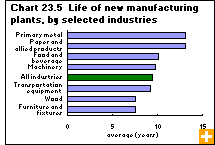Common menu bar links
Manufacturing plants have short lives
Archived Content
Information identified as archived is provided for reference, research or recordkeeping purposes. It is not subject to the Government of Canada Web Standards and has not been altered or updated since it was archived. Please contact us to request a format other than those available.
Manufacturing plants have a life expectancy like humans do. But unlike humans, whose lifespan is rising over time in many countries, manufacturing plants have relatively short lives—most expire early; others may be weak yet cling to life for a time.
Over half of new manufacturing plants shut down by the time they are six years old. By the age of 15, fewer than 20% are still functioning. The average new manufacturing plant in Canada operates for only nine years; 14% of new plants close in their first year.
How long a plant survives varies by industry. The longest lifespan is 13 years, in the primary metals and paper and allied products industries. The shortest is less than eight years in the wood and furniture industries.
The high rate of plant closures means that a person working at one production facility is not likely to have a job that lasts a lifetime. When shutdowns occur, workers might be relocated to other plants within the same firm.
However, when the firm goes out of business, employees often face periods of unemployment. In many cases, workers have no alternative except to take up new positions that often pays less than the job they left.
Manufacturing plants that introduce technological innovations to their manufacturing processes have a higher survival rate than those that put their efforts into changing their products.
Innovation also increases the likelihood that a firm will see higher rates of productivity growth. Though it is the new smaller plants that tend to fold most rapidly, failing to innovate will lead to early death—even for larger plants.



